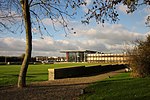Coalpit Heath railway station
1903 establishments in England1961 disestablishments in EnglandFormer Great Western Railway stationsPages with no open date in Infobox stationRailway stations in Great Britain closed in 1961 ... and 3 more
Railway stations in Great Britain opened in 1903South West England railway station stubsUse British English from April 2017

Coalpit Heath railway station served the village of Coalpit Heath, South Gloucestershire, England from 1903 to 1961 on the South Wales Main Line.
Excerpt from the Wikipedia article Coalpit Heath railway station (License: CC BY-SA 3.0, Authors, Images).Coalpit Heath railway station
Ram Hill,
Geographical coordinates (GPS) Address External links Nearby Places Show on map
Geographical coordinates (GPS)
| Latitude | Longitude |
|---|---|
| N 51.5207 ° | E -2.4669 ° |
Address
Coalpit Heath
Ram Hill
BS36 2TX
England, United Kingdom
Open on Google Maps










